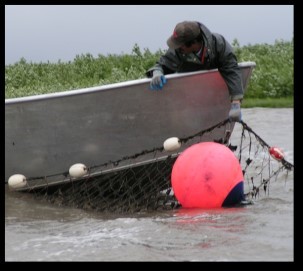The Subsistence hunting and gathering use of all wild resources of birds, mammals, fish, and plants from the tundra, forests, streams, rivers, lakes, seashore, and ocean environments of Alaska.
For some Alaska Native people, the term “Subsistence” is objectionable, as it does not fully describe the cultural importance of this practice. Instead, they prefer the phrase “Our Way of Life” because subsistence practices are closely bound to the lifestyle of Alaska Natives, who have long relied upon the land to not only provide physical sustenance, but also to continue rich and diverse cultural traditions.
Alaska Subsistence Facts
-
The average harvest of subsistence resources is about 276 pounds per rural person per year (compared to 19 pounds per person per year for a non-rural resident)
-
Total statewide annual subsistence harvests is about 33.6 million pounds
- Total wild fish and game harvested for subsistence equals about 0.9% of the total annual harvest by all users including commercial fishers = 98.6%; personal use, sport fishers and hunters = 0.5%
- For Alaska Natives, subsistence plays a key role in their culture, economy, and nutrition
- Subsistence is key to maintaining and preserving AK Native cultures
- Long-standing traditions are associated with gathering, processing/preparing, and sharing of subsistence foods among Alaska Native peoples
- Knowledge about harvest techniques, preparation methods, lore about nature and the environment, and the concepts of sharing and community integrity are passed from elders to young people through participation in subsistence activities, keeping alive these traditions and values
- Subsistence is key to economic survival of Native people in rural Alaska
- Harvesting food from the surrounding lands and waters is a more economical compared to purchasing expensive food items that must be flown into villages
- Subsistence harvested foods has played an even greater economic role in recent years, as a means of compensating for the high costs of living in rural Alaska (e.g., energy and transportation can be many times more expensive than in urban areas)
- A portion of their subsistence harvests have been traditionally sold and bartered by Alaska Natives, to procure necessities such as ammunition and gasoline (to support their subsistence activities), and other basic needs
- Wild-gathered subsistence foods foster good physical and mental health among AK Native people
- Changes in the diet – from more healthy subsistence foods, to less nutritious store bought foods – have contributed to rising health problems among AK Native people
- Subsistence activities provide opportunities for healthy exercise, and provide meaningful purpose to the lives of village residents
- Alaska Native Tribes and organizations have been in the forefront of advocating for subsistence rights before, and after, Title VIII was passed by the Federal government – and they continuously list subsistence as their number one natural resource management issue of concern

The Federal Subsistence Management Program and Federal Subsistence Board
The Title VIII of the Alaska National Interests Conservation Act of 1980 (ANILCA) mandates that rural residents receive priority subsistence use of fish and wildlife resources on Federal lands, including water adjacent to/within these lands. Federal lands include National Parks, Monuments, and Preserves; Fish and Wildlife Service Refuges, Bureau of Land Management lands; National Forests; and other Federal Conservation Status Units (CSU’s) in Alaska. This priority is only available to rural residents, and supersedes the uses of these resources by other groups such as commercial fisherman, sport hunters and fishers, etc. In order to determine the eligibility of communities for priority subsistence purposes, rural status is reviewed every 10 years, and is based mainly on data obtained from the US Census.
The Secretaries of Interior and Agriculture have delegated ANILCA Title VIII responsibilities to the Federal Subsistence Board (FSB). The 8-member Board consists of Regional Directors from five agencies—the Bureau of Indian Affairs, Bureau of Land Management, Fish and Wildlife Service, National Park Service and the Forest Service, and three public members, one of which is the Chair. The public members represent rural Alaska communities.
The BIA has a very crucial role in the Alaska Federal Subsistence Management program, as our agency serves as the primary voice for Alaska Native people in this important Federal responsibility. The BIA Alaska Region is directly responsible for assistance in managing Alaska Native allotments (approximately 1.5 million acres), many of which were selected by Native people for their importance to subsistence activities (e.g., traditional fishing and hunting sites, etc.).
To learn more about the Federal Subsistence Management Program and the Federal Subsistence Board, please click here: US DOI Federal Subsistence Management Program
The Subsistence Branch of BIA Alaska Region has specialists who serve on the Federal Subsistence Management Interagency Staff Committee and Technical Review Committee and provide technical assistance to tribes on subsistence issues.
If you have any questions, please contact:
Glenn K Chen, PhD, Subsistence Branch Chief, Regional Fish & Wildlife Biologist
907-271-4173 or Glenn.Chen@bia.gov
Subsistence harvesting in Alaska is also governed by the following:
Marine Mammal Protection Act
Migratory Bird Treaty Act
Magnuson-Stevens Fishery Conservation Act
International agreements implemented through multi-national commissions such as the Pacific Salmon Commission and the International Pacific Halibut Commission.
The State of Alaska law provides for subsistence priority use of Alaska’s fish and wildlife by all Alaska residents, except in non-subsistence areas defined by the Alaska Boards of Fish and Game.


